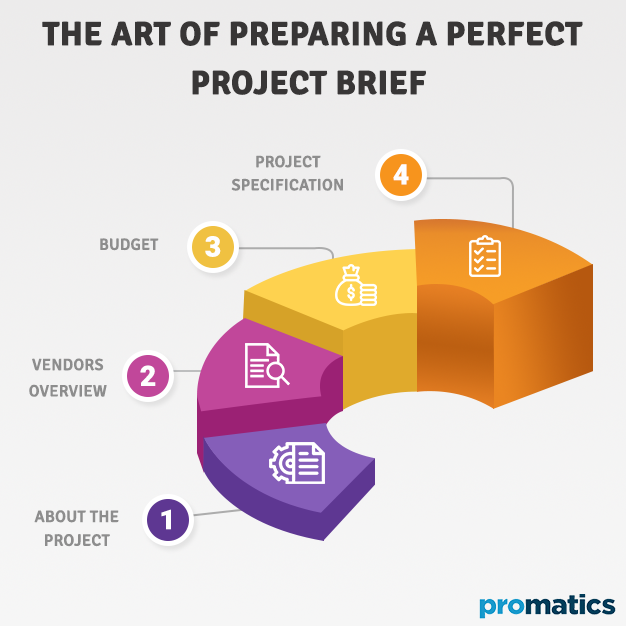How to Write a Perfect Project Brief for Your Outsourcing Vendors?
What is the idea behind successfully attaining a company project?
Does successful project completion only depend on brainstorming? Or is the project’s beginning moment when the company gets to see the end product of your project?
Let me break the bubble of the most complicated face of the business- a project. From the beginning to the end, it demands your full attention, so there is no chance of blunders.
Planning is the root of accomplishing desired goals, especially projects.
Projects don’t happen themselves; a lot of hard work, communication, teamwork, resources, and time requires to achieve the goals successfully. In addition, all these accelerating factors of project completion can be hard to manage without planning and scheduling.
Project planning is a step-by-step, formal or informal, document that gives a roadmap to the team. It clearly states the purpose of achieving goals and clearly outlines where you are standing (beginning) and where you need to reach (project completion). We call it a project brief.
Since projects are quite a complicated business, writing a perfect project brief irrespective of the project nature, whether for yourself or the outsourcing vendors, is a must. Yes, if you think providing a project brief to the outsourcing company wastes time because they are getting paid to provide the products or services (from start to end), you are making your life’s mistake.
Let’s discuss the notion behind outsourcing, why a project brief is important, and how to write a perfect project brief for your outsourcing vendors.
Outsourcing in Business
Outsourcing is a famous business practice where companies hire third-party vendors to provide goods and services instead of doing them themselves. Hiring a supplier to manage operations, provide special services, or produce certain goods has now been trending in businesses for several reasons.
Companies opt for outsourcing to reduce the cost structure because managing specific business operations can be incredibly challenging and expensive. It burdens the financial system because planning for projects, hiring skilled people to perform, getting resources for implementation, and evaluating the results can be overwhelming, expensive, and time-consuming. So, outsourcing proves to be a cost-effective practice to develop, foster, and sustain competitive advantage to nourish the business.
What is a Project Brief?
We all know organizations have particular objectives for which they make short and long-term goals backed by projects. A project is a combination of tasks necessary to attain a plan, but it is not easy as it sounds.
Working on different projects in-house is a different story, but when you outsource tasks, it doubles the risk because the third party isn’t fully aware of the business policies, your culture, and other business aspects. So, here the project brief comes into action.
A project brief is an essential document that outlines the project’s purpose, processes necessary for implementation, timeline, scope, and importance. It may not be detailed as a project plan comprised of fifty pages, but more like a summary to clearly communicate with the team responsible for executing the project.
In simpler terms, a project brief conveys the message of your final goals to the respective members of the team, so you all stay on the same page and avoid any mishaps before, during, or after the project completion.
Importance of Project Brief
Before jumping into more specifics of the project brief and how to write a perfect one for the outsourcing vendors, let’s shed light on its importance and why employees encourage this practice before starting or outsourcing any project.
The most crucial reason why project plans are required is that they help you see your project from start to end and figure out how to go from point A to B. According to the experts in project management, project plans are a great tool that helps strategize the path to success while giving ample opportunity to monitor the factors impacting the project, including stakeholders’ requirements, budget, and scheduled days, and helps in planning to deal with any risks beforehand.
The Project brief keeps everyone working on the tasks on the same page while clearly communicating the expectations from each member.
In addition, it also works as a framework that helps measure progress and success, so everyone can easily take corrective measures before any noticeable blunder.
Why Prepare a Project Brief? – Project Planning Purpose
When you are required to present a business pitch to your clients, you don’t just go before the client and start speaking, right?
There must be a process you follow to prepare yourself and pitch so you can secure a business deal and move forward in the business. That is why you need to write an rfp for web development or app development.
You must prepare an attractive yet detailed presentation that describes what you want to do and how you will do it. It must include how much time you require, the limitations, the scope of your offer, the success or failure rate, and the budget. Sometimes an effective business pitch decides whether you secure or lose the deal, so the smart managers put extra effort into the presentation.
Similarly, the notion behind preparing a project brief is making a template or a step-by-step guide about the particular project for the supplier who will be responsible for executing it. It will open the door to communication between two parties who are after a similar goal.
Who Creates a Project Brief?
Anyone who has excellent knowledge about the project can create a project brief for the outsourcing vendors. However, a project manager is recommended to take responsibility for designing the project brief because he must have expertise in the field and have enough knowledge and skills about managing resources, assigning tasks, and monitoring the progress.
Besides, it is not a one-man show. The project involves many indicators, from resources to schedule and communicating with the project stakeholders and employees; everyone on the top management has to be on the same page. When you hire a third party to do tasks for you, you must be very careful and maintain continuous communication to answer their queries and ensure a smooth flow to avoid any mishap.
So, whoever is responsible for making a project brief, should be qualified enough about the project goal, necessary tools, timelines, deliverables, project outcomes, clients, past encountered issues, scope, processes, and reasonable approach for measuring the progress.
How to Prepare a Project Brief?
Preparing a project brief is an art. Communicate with your team about the plan, grab a coffee, and start designing the document for the outsourcing vendor. Remember that you have to convey the message to the one who is not a part of your company and may not be aware of your day-to-day routine, so it has to be casually formal.
You have to describe all the necessary elements of the project while keeping it brief, more like a summary or business pitch in written form.
The format of the project brief can vary depending on the projects or the clients. There are also many projects brief templates available that you can use to save time, add information, and boom.
Let’s discuss how to prepare a perfect project brief for outsourcing vendors in a few simple steps.
About the Project
Start with digging deep into the project. Before going to the outsourcing party, you must know every bit of your project and keep the important points at your fingertips.
It is better to understand the nature of the project, similar projects you have executed in the past, and their outcomes. When you are strong about your goals and concern, you can deliver to others better than expected.
After understanding the project, the next step is what sort of deliverables you have and at what deadline. That’s how you can find, judge, and shortlist the outsourcing vendors based on their expertise.
Vendors Overview
If you are convinced you will outsource the project, get a better hold of your vendors. Check their portfolio and discover if they had completed similar tasks before and what was the success rate. Good communication skills can fill the gap between transferring your knowledge and getting the right product/service.
While designing the project brief template, don’t forget to mention your client’s name, necessary information, and successful projects.
Budget
Be clear about your budget in the project brief and leave no room for confusion in this regard. Read about your rights when outsourcing the work, and don’t make the full payment altogether.
Pitch the vendor about any limitations (if you have any) and be clear about all the cashflows going in and out for this project. Don’t hesitate to mention the budget in the brief template.
Project Specification
Be clear about the purpose of the project, timeframe of the final product, time restriction on deliverables (if any), target audience, etc.
When setting a project objective, opt for the SMART method. Whether you are executing the goal or the vendor, it should be specific, measurable, achievable, realistic, and time-bound.
Be clear about why this project is important for your business. Why did you plan this? For whom did you plan it? What are your expectations with it? How many resources can you manage to provide? How will you monitor the progress? And will you maintain a long-term relationship with the vendor after its completion?
Elements of Project Brief
There is no traditional trick for preparing a perfect project brief for the outsourcing vendor. The company uses different templates, adds elements of their choice that best represent their concerns, and customizes according to the task’s nature.
However, a few must-have elements can raise the bar and help you effectively design a project brief without wasting much time. Think of it as nothing different than the project plan, but a little brief you can go through and understand in a few minutes.
So, let’s quickly go through the essential elements of a perfect project brief template.
a.) Company’s vision
b.) The main objective of the project
c.) Company profile
d.) Vendor profile
e.) Budget
f.) Deadline
g.) Progress reports
h.) In-between meeting scheduling
What to Avoid when Creating a Project Brief
Confusing Language/Communication
When writing a project brief, don’t use business jargon and hard vocabulary that other person finds hard to understand. Your plan should stalk clarity whether you define the target audience or define your goals; every word should scream your thoughts in easy language.
Buzzing on It
Don’t try to find the shortcut. Do the hard work and do proper research. Talk to the relevant people who can help you understand if you lack the knowledge and experience. Remember, you can only communicate confidently when you know things by yourself.
If you fail to deliver your concerns to the team, the project and you will suffer all along.
Generalization
Many people think giving too much information and dictating the task would help, but it can ruin the whole project. Be specific about what you want and leave the how-to-do part to the vendor.
Ending Thoughts
Writing a project plan can be overwhelming, especially when you are not used to it. But, it can be fun when you know how to do it. Head over to the article and learn in detail how to prepare a perfect project brief and sustain a long-term relationship with your outsourcing vendors while watching the success of your project thrive.
Happy Planning!
Still have your concerns?
Your concerns are legit, and we know how to deal with them. Hook us up for a discussion, no strings attached, and we will show how we can add value to your operations!

